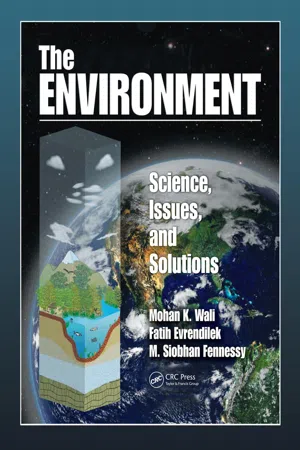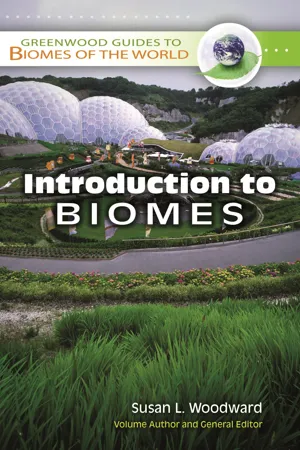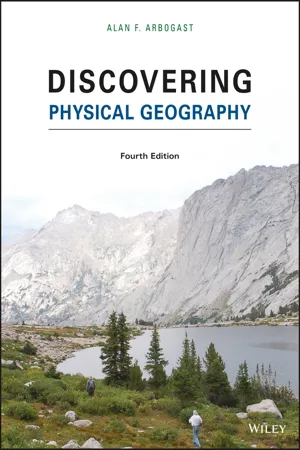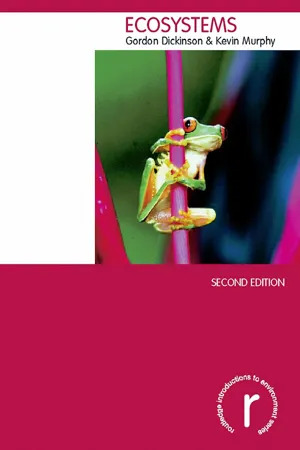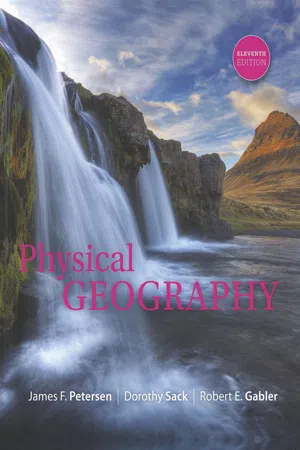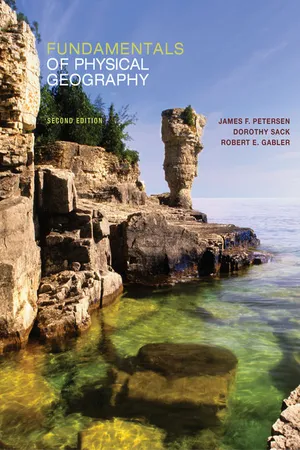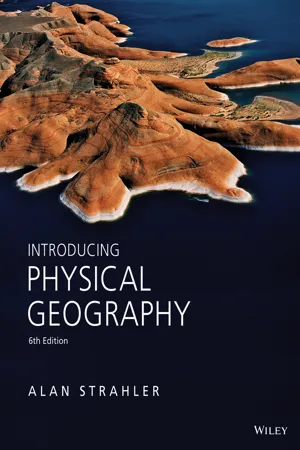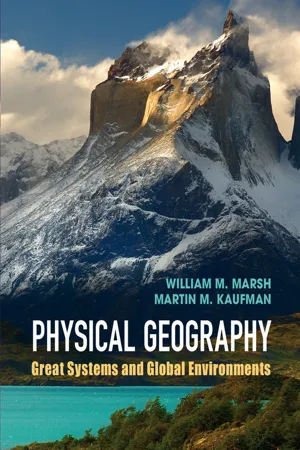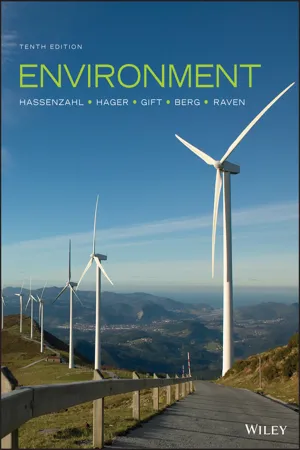Geography
Biomes
Biomes are large geographical areas characterized by their distinct climate, flora, and fauna. They are typically classified into categories such as deserts, forests, grasslands, and tundras. Each biome has its own unique set of environmental conditions and supports specific types of plant and animal life, playing a crucial role in the Earth's biodiversity and ecosystem.
Written by Perlego with AI-assistance
Related key terms
1 of 5
10 Key excerpts on "Biomes"
- eBook - PDF
The Environment
Science, Issues, and Solutions
- Mohan K. Wali, Fatih Evrendilek, M. Siobhan Fennessy(Authors)
- 2009(Publication Date)
- CRC Press(Publisher)
179 Topics Introduction Biomes Tundra and Alpine Taiga Temperate Deciduous Forest Grassland Temperate Coniferous Forest Dry-Mesic Forest Temperate Rain Forest Desert Tropical Rain Forest Tropical Savannas Ecotones Ecoregions 10 Biomes—the Major Ecosystems of the World Introduction For many years, ecologists have sought to understand how geogra-phy, climate, and other factors generate global patterns of species dis-tribution. European scientists in the nineteenth century stressed the roles of precipitation and temperature. In the United States, C. Hart Merriam (1894) stressed how temperature controls the geographic distribution of terrestrial animals and plants and formulated the “life zones.” The life zone characteristics were also the basis for delin-eating the crop zones of the United States and are still in use. In the field of ecology, the recognition of “climax” (or old-growth) communi-ties, discussed in the last chapter, led to the concept of Biomes. Biomes The following three definitions capture the essence of our current understanding of the biome concept: Regional climates interact with regional biota and substrate to produce large, easily recognizable community units, called Biomes. The biome is the largest land community unit [that] it is convenient to recognize. (Odum 1971, p. 378) A biome is a grouping of terrestrial ecosystems on a given continent that are similar in vegetation structure or physiognomy, in the major features of the environment to which this structure is a response, and in some characteristics of their animal communities. (Whittaker 1975, p. 135) A biome includes all animals and plants adapted to common climate, which thus share habitats and must accommodate to each other. The animals of a biome are further constrained by the physical structures of plant design … Thus a biome is community in which the living things offer solutions to a common problem; they are environmentally linked. - eBook - PDF
- Susan L. Woodward(Author)
- 2008(Publication Date)
- Greenwood(Publisher)
If it were possible to see the Earth as a whole, you would see that the same re- gional vegetation types of North America—and some new ones—occur on other continents as well. Wherever climates are similar, the vegetation looks pretty much the same. The animals, invisible at this global scale, may or may not be similar. 1 When you see the same type of vegetation developed under similar climates on dif- ferent continents, you are looking at a biome. Study of the biome reveals just how similar or how different the component plants and animals actually are and raises questions about why plants and animals are distributed on the Earth they way they are. Answers lie in past processes and events: in Earth history (geology and clima- tology), evolutionary history (biology), the dispersal history of organisms (biogeog- raphy), and the current environmental conditions on the planet (geography, ecology, meteorology—and economics). This book introduces concepts from a va- riety of research fields that help us understand and appreciate the complexities that create and underlie each major biome. Definition of Biome The term biome is somewhat vaguely defined, and different interpretations of its meaning are emphasized by different fields of science and on different continents. Most often, the definition embraces the notion of a community of plants and ani- mals characteristic of a particular climate region. In the United States, the commu- nity is often regarded as part of an ecosystem, so the definition may include not only the living parts but also nonliving or abiotic elements such as soil and the other aspects of the physical environment with which the plants and animals inter- act (see Table 1.1). - eBook - PDF
- Alan F. Arbogast(Author)
- 2017(Publication Date)
- Wiley(Publisher)
Each biome is a distinct ecosystem and thus has a particular community of plants, animals, and microorganisms that are linked by energy and nutrient flows. Although ecosystems can be viewed at many different scales, this part of the chapter focuses on the plant communities in large areas that typically cover thousands of square kilometers. Although the biome concept also includes information about the character of soils, the major Biomes are described here because vegetation is the most visible component of a biome. The relationship of soils to vegetation and climate will be covered in Chapter 11. This section of the chapter focuses on geographic units as they relate to potential natural vegetation—that is, the vege- tation you would find in a region if humans did not modify the landscape. Figure 10.6 is a map showing the distribution of the Tropical Rainforest Tropical Deciduous Forest and Scrub Midlatitude Deciduous Forest Mediterranean Woodland and Shrub Midlatitude Coniferous Forest Boreal Forest T ropical Savanna Midlatitude Grassland Hot and Dry Desert Semi-arid and Cold Desert Tundra Arctic and Alpine Ice 0° 0° 30° 30° 30° 60° 150° 120° 90° 90° 60° 60° 30° 30° 0° INDIAN OCEAN ATLANTIC OCEAN PACIFIC OCEAN PACIFIC OCEAN Equator Tropic of Cancer Tropic of Capricorn FIGURE 10.6 Map of global Biomes. Compare this figure with Figure 9.2, which shows the distribu- tion of climate regions, and note some of the similarities and differences. Potential natural vegetation The vegetation that would occur nat- urally within a specific area if no human influence occurred. Biome The complex of living communities maintained by the climate of a region and characterized by a distinctive type of vegetation. The Relationship of Climate and Vegetation: The Character and Distribution of Global Biomes 211 12 Biomes, and Table 10.1 outlines their fundamental char- acteristics. You should refer to this map and table frequently as you read this section. - eBook - ePub
- Gordon Dickinson, Kevin Murphy(Authors)
- 2007(Publication Date)
- Routledge(Publisher)
8 Biomes: world ecosystem types
The surface of the Earth is occupied by distinctive plant and animal communities – Biomes – occupying large areas, and with broad functional ecological characteristics which address the challenges and opportunities of the environments in which they are set. The pattern of Biomes is essentially controlled by primary production, which provides the energy base for the biological communities that make up each biome. There are wide variations in productivity, and thus great variation in the types of plants, which form the dominant biota in a biome. Primary biological productivity is controlled by a series of abiotic environmental factors. In terrestrial environments, heat and water availability are the most important at a global scale. Thus the world pattern of terrestrial Biomes is closely related to global climates. Human influences are becoming an increasingly important element affecting the nature of Biomes. This chapter covers:- What are Biomes?
- Biomes and the factors which control primary production
- The global pattern of Biomes
- Variations within Biomes and the human factor in Biomes
What are Biomes?
Biomes as defined in the glossary are regional-scale assemblages of ecosystems. To some extent there is congruence between the two concepts. However, Biomes are the largest scale of unit, and as is discussed in this section the role of climate in defining and controlling terrestrial Biomes is regarded as fundamental. In this chapter the reasons why these patterns develop are examined, and terrestrial Biomes are analysed in detail. Although there is no detailed treatment of aquatic Biomes, this should not be taken to mean that these are unimportant. Quite the reverse is true. Oceanic and other aquatic ecosystems are responsible for about half of all photosynthetic activity, and probably most chemosynthetic production. Furthermore, there are complex and interactive links between marine ecosystems and energy and material flows, as has already been discussed in Chapters 3 - No longer available |Learn more
- James Petersen, Dorothy Sack, Robert Gabler(Authors)
- 2016(Publication Date)
- Cengage Learning EMEA(Publisher)
289 BIOGEOGRAPHY IS THE STUDY OF how environmental factors affect the locations, distributions, and life processes of plants and animals. Basically, this discipline seeks explanations for the geography of life forms. Biogeographers delineate the spatial boundaries of natural environments and investigate how and why environmental characteristics change spatially and over time. Along with ecologists and scientists from other disciplines, biogeographers often study ecosystems. An ecosystem is a community of organisms that occupy a given area, along with their interdependent relationships with each other and with characteristics of the nonliving environment. Biogeography is also concerned with both human and natural impacts on organisms and their ecosystems. It also focuses on how those external influences affect the environmental conditions that support life. Ecology is an old science. The voyages of discovery beginning in the fifteenth century carried colonists and explorers to uncharted lands with exotic environments. Scientists eventually accompanied exploratory voyages travelling to distant places and recording descriptions and illustrations of the previously unknown flora and fauna they encountered. It was apparent that certain plants and animals that were found together bore direct relationships to the climate and environment in which they lived. As widespread information about global environments became more complete and ■ 11.1 Define the four major components of an ecosystem, and explain their inter-dependence. ■ 11.2 Recognize that other environmental controls may be more important on a local scale but that climate has the greatest influence over ecosystems on a worldwide basis. ■ 11.3 Explain how vegetation becomes established on barren or devastated areas, and cite an example of the steps in plant succession. ■ 11.4 Provide examples of how plants, animals, and the environments in which they live are interdependent, each affecting the others. - eBook - PDF
- James Petersen, Dorothy Sack, Robert Gabler, , James Petersen, Dorothy Sack, Robert Gabler(Authors)
- 2014(Publication Date)
- Cengage Learning EMEA(Publisher)
In a terrestrial ecosys-tem, the abiotic component provides life-supporting elements and compounds from the soil, the groundwater, and the atmosphere. Biogeography is the study of how environmental factors affect the locations, distributions, and life processes of plants and animals. Basically, this discipline seeks explanations for the geography of life forms. Biogeographers delineate the spatial boundaries of ecosystems, and they investigate how and why environmental characteristics change spatially and over time. Soils are intimately related to the factors that influence the biogeography of an area. The characteristics of a soil reflect the interactions among the climate, vegetation, rocks, minerals, and fauna at its location. Soils also host and support microenvironments teeming with organisms living on and beneath the surface. Relationships and interactions among the different climate regions, their associated vegeta-tive Biomes, and certain soils were introduced in Chapters 7 and 8. In this chapter, we take a closer look at biogeography and at the nature of soils. Ecosystems The term ecosystem refers to a community of organisms that occupy a given area, and the interdependent relationships—with one another and the environment—that allow the organisms to thrive ( ■ Fig. 9.1). Ecosystems can be large or small, terrestrial (land based), aquatic or marine, and short lived or long last-ing. Generally, ecosystems are studied on a local or regional basis, but the entire Earth system (the ecosphere ) also functions as an ecosystem. When farmers plant crops, spread fertilizer, control weeds, and use insecticides, new ecosys-tems (although artificial) are created. Despite environmental alterations by human activities, plants and animals that can adapt still live together in interdependent relationships with soil, rainfall, temperatures, sunshine, and other characteristics of the physical environment. - eBook - PDF
- Alan H. Strahler(Author)
- 2013(Publication Date)
- Wiley(Publisher)
Temperatures can range from very hot to cool. Plants of the desert biome are often xero- phytes, which have adapted to the dry environment. ■ Plant life in the tundra biome is limited by cold temperatures. Only small plants that can grow quickly when temperatures warm above freezing in the warmest month or two can survive. Biogeographers break down the five principal Biomes into smaller vegetation units, called formation classes, using the life-form of the plants. For example, at least four and perhaps as many as six kinds of forests can be distinguished within the forest biome. At least three kinds of grasslands are easily recognizable. Deserts, too, span a wide range in terms of the abundance and life-form of plants. The formation classes described in the remaining portion of this chapter are major, widespread types that are clearly associated with specific climate types. Natural Vegetation Regions of the World Take a second look at the world map of vegetation regions, and click on a formation class or biome to see a characteristic photo. An animation. Biomes, FORMATION CLASSES, AND CLIMATE The pattern of formation classes depends heavily on climate. As climate changes with latitude or longitude, vegetation will also change. Figure 9.6 shows how veg- etation formation classes respond to temperature and Equatorial and tropical-zone rainforest Monsoon forest Savanna Semidesert Desert shrub and desert Midlatitude deciduous forest Tall-grass and short-grass prairie Semidesert Desert shrub and desert Coastal forest DECREASING PRECIPITATION Hot DECREASING TEMPERATURE Cold Arctic INCREASING LATITUDE Equatorial zone Dry Wet Tundra Boreal forest 9.6 Vegetation types and climate T emperature and precipitation are the two most important factors in deter- mining the pattern of natural vegeta- tion types. Biogeographers rec- ognize five principal Biomes: forest, grassland, savanna, desert, and tun- dra. - eBook - PDF
- Julianne Zedalis, John Eggebrecht(Authors)
- 2018(Publication Date)
- Openstax(Publisher)
The same biome can occur in different geographic locations with similar climates. Temperature and precipitation, and variations in both, are key abiotic factors that shape the composition of animal and plant communities in terrestrial Biomes. Some Biomes, such as temperate grasslands and temperate forests, have distinct seasons, with cold weather and hot weather alternating throughout the year. In warm, moist 1576 Chapter 35 | Ecology and the Biosphere This OpenStax book is available for free at http://cnx.org/content/col12078/1.6 Biomes, such as the tropical wet forest, net primary productivity is high, as warm temperatures, abundant water, and a year-round growing season fuel plant growth. Other Biomes, such as deserts and tundra, have low primary productivity due to extreme temperatures and a shortage of available water. 35.4 Aquatic Biomes Aquatic ecosystems include both saltwater and freshwater Biomes. The abiotic factors important for the structuring of aquatic ecosystems can be different than those seen in terrestrial systems. Sunlight is a driving force behind the structure of forests and also is an important factor in bodies of water, especially those that are very deep, because of the role of photosynthesis in sustaining certain organisms. Density and temperature shape the structure of aquatic systems. Oceans may be thought of as consisting of different zones based on water depth and distance from the shoreline and light penetrance. Different kinds of organisms are adapted to the conditions found in each zone. Coral reefs are unique marine ecosystems that are home to a wide variety of species. Estuaries are found where rivers meet the ocean; their shallow waters provide nourishment and shelter for young crustaceans, mollusks, fishes, and many other species. Freshwater Biomes include lakes, ponds, rivers, streams, and wetlands. Bogs are an interesting type of wetland characterized by standing water, lower pH, and a lack of nitrogen. - eBook - PDF
Physical Geography
Great Systems and Global Environments
- William M. Marsh, Martin M. Kaufman(Authors)
- 2012(Publication Date)
- Cambridge University Press(Publisher)
With the exception of the boreal forests, temperate forests have been severely altered by land use. 3 3 Savanna Biomes are found in the tropical wet–dry climatic zone. There are two main varieties of savanna Biomes and one is noted for abundant grazing animals and associated predators. 3 3 Grasslands are found mainly in the semiarid climatic zones. Trees and shrubs are scarce and occupy slightly wetter habitats such as stream valleys. 3 3 Desert Biomes rank among the least productive Biomes. Shrub deserts have heavier plant covers and are more productive than dry desert Biomes. 3 3 The tundra biome is found beyond the limits of tree growth. Beyond the tundra and alpine meadow Biomes is fell, which is comparable to dry deserts in productivity and flora diversity. 3 3 Within the major Biomes are secondary distribution patterns. These occur at small scales and are related to geographic settings like river corridors and mountain ranges. 3 3 Disturbances can cause major changes in the makeup and distribution of biota. Disturbances come in all sizes from local to global and all frequencies from days to millions of years. 3 3 Three major concepts help explain how geographic change takes place in biota. Disturbance theory argues that the distribution of biota fluctuates in response to the magnitude and frequency of disturbance events. 3 3 The Mt. St. Helens eruption was major disturbance event. The patterns of recovery of the disturbance area by plants and animals do not follow the succession-community concept. The Greek playwright Euripides wrote that a bad beginning makes for a bad ending. Although humans had a tough beginning, after thousands of years better times eventually emerged as people spread over much of the world and adapted to different landscapes. But with technological advances and the pressure of growing population, adaptation changed to more and more serious forms of environmental manipulation. - eBook - PDF
- David M. Hassenzahl, Mary Catherine Hager, Nancy Y. Gift, Linda R. Berg, Peter H. Raven(Authors)
- 2018(Publication Date)
- Wiley(Publisher)
Light is relatively plentiful in most Biomes, except in certain environments such as the rainforest floor, or polar regions, where days are short or nonexistent in winter. Other abiotic factors to which certain Biomes are sensitive include tem- perature extremes as well as rapid temperature changes, fires, floods, droughts, and strong winds. While there are many ways to classify land types, scien- tists find it useful to consider nine major Biomes. The follow- ing section describes these Biomes, and explores how human activities impact them. Tundra: Cold Boggy Plains of the Far North Tundra (also called arctic tundra) occurs in the extreme northern latitudes wherever the snow melts seasonally (Figure 6.3). The 0 0 1000 2000 Kilometers 1000 2000 Miles 0° 0° 30° S 30° N 60° N 60° S 30° S 30° N 60° N 60° S Tundra Boreal forest Temperate deciduous forest and temperate rain forest Temperate grassland Chaparral Desert and dry shrubland Tropical rain forest Tropical dry forest Savanna Mountains with complex zonation FIGURE 6.1 Distribution of the world’s terrestrial Biomes. Although sharp boundaries are shown in this highly simplified map, Biomes actually blend together at their boundaries. (Based on data from the World Wildlife Fund) tundra The treeless biome in the far north that consists of boggy plains covered by lichens and small plants such as mosses; has harsh, very cold winters and extremely short summers. Earth’s Major Biomes 115 DECREASING PRECIPITATION Hot DECREASING TEMPERATURE Cold Arctic INCREASING LATITUDE Tropics Dry Wet Tundra Boreal forest Tropical rain forest Dry tropical forest Savanna Moist tropical desert Dry tropical desert Temperate deciduous forest Temperate grassland Chaparral Temperate desert FIGURE 6.2 Temperature and precipitation. The Biomes are distributed primarily in accordance with two climate factors, temperature and precipitation. In the higher latitudes, temperature is the more important of the two.
Index pages curate the most relevant extracts from our library of academic textbooks. They’ve been created using an in-house natural language model (NLM), each adding context and meaning to key research topics.
